-
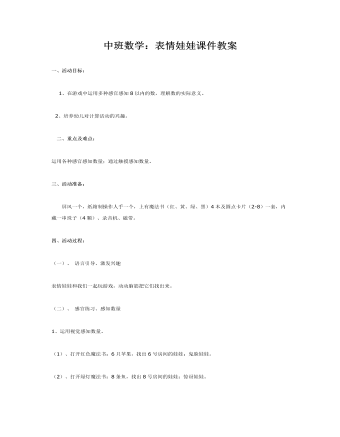
中班数学:表情娃娃课件教案
2、培养幼儿对计算活动的兴趣。 二、重点及难点: 运用各种感官感知数量;通过触摸感知数量。 三、活动准备: 屏风一个,纸箱制操作人手一个,上有魔法书(红、黄、绿、黑)4本及圆点卡片(2-8)一套,内藏一串珠子(4颗)、录音机、磁带。 四、活动过程: (一)、语言引导、激发兴趣 表情娃娃和我们一起玩游戏,动动脑筋把它们找出来。
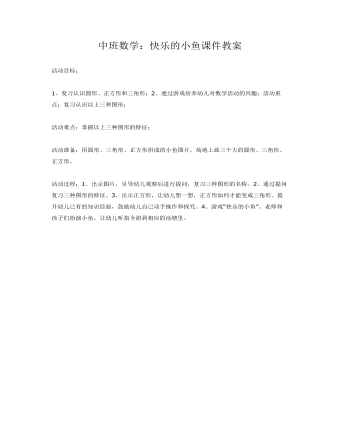
中班数学:快乐的小鱼课件教案
2、通过游戏培养幼儿对数学活动的兴趣;活动重点:复习认识以上三种图形;活动难点:掌握以上三种图形的特征;活动准备:用圆形、三角形、正方形拼成的小鱼图片,场地上画三个大的圆形、三角形、正方形。
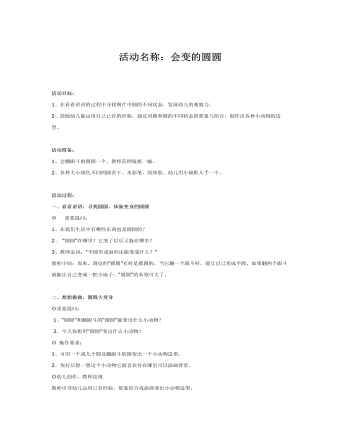
中班数学:会变的圆圆课件教案
2、鼓励幼儿能运用自己已有的经验,通过对圆和圆的不同状态的想象与组合,创作出各种小动物的造型。 活动准备:1、会翻跟斗的圆圆一个、教师范例镜框一幅。 2、各种大小颜色不同的圆若干、水彩笔、固体胶、幼儿用小镜框人手一个。 活动过程:一、看看讲讲,寻找圆圆,体验变身的圆圆◎ 重要提问:1、在我们生活中有哪些东西也是圆圆的?2、 “圆圆”在哪里?它变了以后又躲在哪里?3、教师追问:“半圆形或扇形还能变成什么?”教师小结:原来,调皮的“圆圆”有时是圆圆的,当它翻一个跟斗时,能让自己变成半圆,如果翻两个跟斗就能让自己变成一把小扇子,“圆圆”的本领可大了。
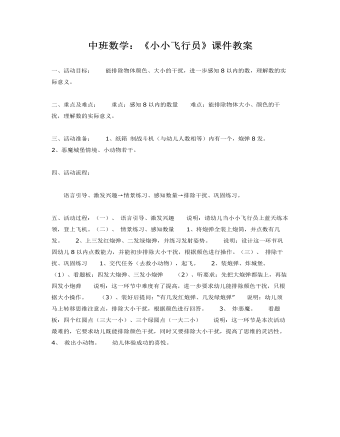
中班数学:《小小飞行员》课件教案
二、重点及难点: 重点:感知8以内的数量 难点:能排除物体大小、颜色的干扰,理解数的实际意义。三、活动准备: 1、纸箱制战斗机(与幼儿人数相等)内有一个,炮弹8发。 2、恶魔城堡情境、小动物若干。四、活动流程: 语言引导、激发兴趣→情景练习、感知数量→排除干扰、巩固练习。五、活动过程:(一)、语言引导、激发兴趣 说明:请幼儿当小小飞行员上蓝天练本领,登上飞机。
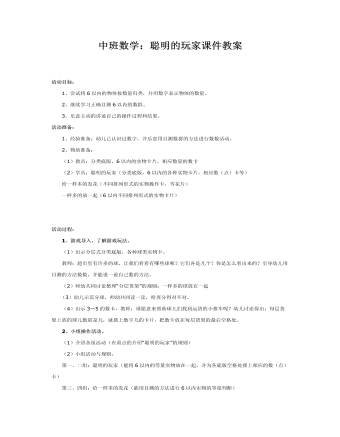
中班数学:聪明的玩家课件教案
2、继续学习正确目测6以内的数群。3、乐意主动的讲述自己的操作过程和结果。活动准备:1、经验准备:幼儿已认识过数字,并乐意用目测数群的方法进行数数活动。2、物质准备: (1)教具:分类底版,6以内的实物卡片,相应数量的数卡 (2)学具:聪明的玩家(分类底版,6以内的各种实物卡片,相应数(点)卡等) 给一样多的发花(不同排列形式的实物操作卡,雪花片) 一样多的放一起(6以内不同排列形式的实物卡片)

中班数学:复习几何图形课件教案
2、让幼儿大胆想象,运用几何图形进行拼搭创造。活动准备:图形宝宝图片、背景图、固体胶、纸、环境布置活动重点:复习巩固对几何图形的认识活动难点:运用几何图形进行拼搭创造活动流程:引出课题 游戏巩固 活动延伸
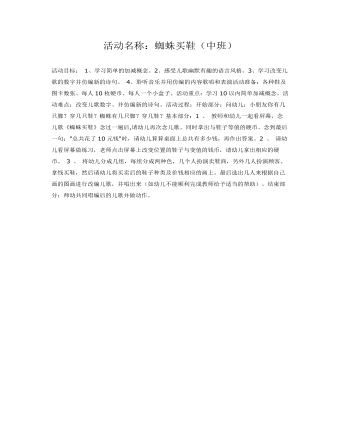
中班数学:《蜘蛛买鞋》课件教案
2、感受儿歌幽默有趣的语言风格。3、学习改变儿歌的数字并仿编新的诗句。 4、聆听音乐并用仿编的内容歌唱和表演活动准备:各种鞋及图卡数张、每人10枚硬币、每人一个小盒子。活动重点:学习10以内简单加减概念。活动难点:改变儿歌数字、并仿编新的诗句。活动过程:开始部分:问幼儿:小朋友你有几只脚?穿几只鞋?蜘蛛有几只脚?穿几鞋?基本部分:1 、教师和幼儿一起看屏幕,念儿歌《蜘蛛买鞋》念过一遍后,请幼儿再次念儿歌。同时拿出与鞋子等值的硬币、念到最后一句:"总共花了10元钱"时,请幼儿算算桌面上总共有多少钱,再作出答案。

中班数学:7是多少课件教案
准备 l~7数字卡片若干套,画有不同数目的图片若干套(两个小人;两件衣服;一个杯子、一顶帽子;3只鸭;一根蚊香、一瓶香水、一枝月季;一个苹果、一个香蕉、一对连枝樱桃、一块糖……)。
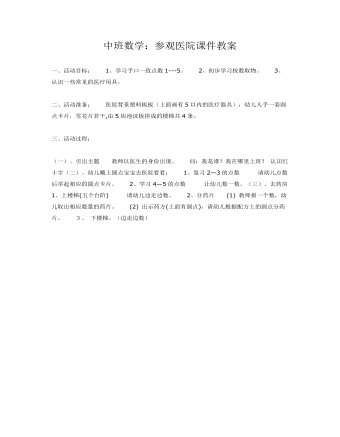
中班数学:参观医院课件教案
二、活动准备: 医院背景塑料板板(上面画有5以内的医疗器具),幼儿人手一套圆点卡片,雪花片若干,由5块泡沫板拼成的楼梯共4条。三、活动过程:(一)、引出主题 教师以医生的身份出现。 问:我是谁?我在哪里上班?认识红十字(二)、幼儿戴上圆点宝宝去医院看看: 1、复习2—3的点数 请幼儿点数后举起相应的圆点卡片。
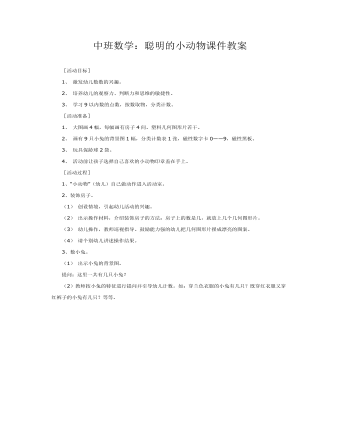
中班数学:聪明的小动物课件教案
2、培养幼儿的观察力、判断力和思维的敏捷性。3、学习9以内数的点数,按数取物,分类计数。 [活动准备]1、大图画4幅,每幅画有房子4间。塑料几何图形片若干。2、画有9只小兔的背景图1幅,分类计数表1张,磁性数字卡0——9,磁性黑板。3、玩具保龄球2袋。
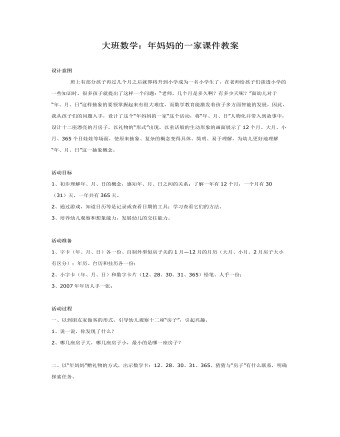
大班数学:年妈妈的一家课件教案
活动目标1、初步理解年、月、日的概念,感知年、月、日之间的关系;了解一年有12个月,一个月有30(31)天,一年共有365天。2、通过游戏,知道日历等是记录或查看日期的工具;学习查看它们的方法。3、培养幼儿观察和想象能力,发展幼儿的交往能力。 活动准备1、字卡(年、月、日)各一份、自制外型似房子关的1月—12月的月历(大月、小月、2月房子大小有区分);年历、台历和挂历各一份;2、小字卡(年、月、日)和数字卡片(12、28、30、31、365)铅笔、人手一份;3、2007年年历人手一张;

人教版新目标初中英语九年级上册Teenagers should be allowed to choose their own clothes教案2篇
Step 1 Greeting Greet the class and check the homeworkStep 2 A duty report The S on duty gives a report on the rules in his home and lead in 3a “Sun Fei’s and Wu Yu’s rules” Step 3 ReadingSs read the conversation and write the two girls’ rules in the chart. Check the answers.Get Ss to read after the tape and then read aloud by themselves. Then, T explains the language points.Step 4 Pairwork 3bRole play. Use the information in chart to practice with the conversation in 3a covered. They can look at the sample conversation in the right box.Step 5 Task 2 “Who’s the best reporter?”Make a survey by asking any 5 students the questions in the chart in activity 4. Then give out a report about it. See who is the best reporter? And the best reporter will get a nice ball-pen.Step 6 Summary and homework:Write out the report in your exercise-books.Period ThreeStep 1 Greeting and a duty reportThe S gives a duty report talking about his experience of being late for school. Lead in the question “Do you ever get to school late? How often do you get to school late? Always, usually, sometimes, or never?Step 2 1a Get Ss to finish writing.Step 3 Pairwork 1b Get Ss to talk about their answers with their partners using the sample conversation in the box on the right.Step 4 Listening practice2a Lead-in: What will happen if you get to school late? What about Peter? Let’s listen to a conversation between Peter and his father. Get Ss to finish 2a (As usual, for the first time, Ss only listen.) Check the answers.

人教版新目标初中英语九年级上册How do you study for a test教案2篇
内容提示本单元主要内容是学会利用verb十by/with gerund表示方式方法来讨论学习英语的策略,认识自己在学习方面的长处和不足。初步了解现在完成时的结构和用法。现在完成时由助动词have/has+动词的过去分词构成,主要表示过去发生的某一动作对现在仍有影响或造成的后果,常与already,yet,just,ever,never等副词连用。教学目标一、学习目标(Language Goal) 1. Talk about how to study . 学会讨论各种学习方法和策略。2. Find out your suitable learning methods. 找出适合自己的学习方法。 二、语言结构(Language Structures) 1. Verb + by with gerund by+动名词短语 表示“通过…途径,方法” 2. How questions have引导的特殊疑问句 三、目标语言(Target Language) 1. How do you study for tests ? 你是怎样准备考试的?Well , I study by working with my classmates. 哦,我和同学们一起学习。2. Have you ever studied with a group ? 你曾经参加过学习小组吗?Yes , I have . I’ve learned a lot that way . 是的,参加过。通过这种方式我学了许多。

人教版新目标初中英语九年级上册It must belong to Carla教案
一、Section A该部分有4个模块。第一模块围绕Whose volleyball is this? 这一话题展开思维( 1a)、听力(1b)、口语( 1c)训练;第二模块围绕上一模块中的话题进行听力( 2a-2b)、口语训练( 2c);第三模块继续围绕前两个模块中的“making inferences”展开训练。训练形式为阅读排序( 3a)和两人问答(3b);第四模块仍就上一话题展开讨论。二、Section B该部分有4个模块。第一模块要求根据图画和所提供的单词写出合理的句子;第二模块在听力( 2a-2b)和分角色口语训练( 2c)的基础上,继续进行“推测”训练; 第三模块围绕“Strange events in Bell Tower neighborhood”这一话题展开阅读( 3a)和写作(3b -3c)训练;第四模块以dream为话题展开小组活动。三、Self Check该部分有3个模块。第一模块以填空形式对所学词汇进行训练;第二模块就8个谚语展开阅读和讨论。

人教版新目标初中英语九年级上册Where would you like to visit教案2篇
The First PeriodⅠ.Teaching Aims and DemandsKnowledge Objects(1) Key Vocabularytiring, educational, fascinating, thrilling, peaceful, exotic, trek, jungle, take it easy, explore, historic, site(2) Target LanguageWhere would you like to go on vacation?I’d like to trek through the jungle, because I like exciting vacations.2. Ability Objects(1)Train students to talk about places they would like to visit with the target language.(2)Train students to describe vacations with different adjectives.(3)Train students' listening skill.3. Moral Object,It′s more interesting to go on vacating somewhere instead of staying at home.Ⅱ. Teaching Key Points1. Key Vocabularytiring, educational, fascinating, thrilling, peaceful, exotic, trek, jungle, take it easy, explore, historic, site2. Target LanguageTalk about different places with the target language.Ⅲ. Teaching Difficult Points1. Describe vacations with different adjectives.2. Talk about different places with the target language.Ⅳ. Teaching Methods1. Teaching by illumination2. Teaching by doing chain drills3. Teaching by pairworkⅤ. Teaching Aids1. A tape recorder2. Some pictures of different places with famous views

人教版新目标初中英语九年级上册I like music that I can dance to教案
教学目标: 1. Express preferences2. Talk about one’s likes and dislikes and the reasons3. Learn to express one’s opinions 4. Learn to write a reply 语言功能: 1) Talk about one’s preferences, using t he relative clause2) Talk about people’s likes and dislikes and the reasons3) Talk about opinions语言结构: Relative clauses with that and who语言目标:What kind of music do you like?I like music that I can sing along with.I love singers who write their own music.We prefer music that has great lyric.重点词汇及短语:heart, photography, interest, class, whatever, miss, okay, expect, sweet, taste, itself, laboratory, cancer, increase, biscuit, main, care, prefer… to…, remind somebody of …, dance to, sing along with, be sure to, interest somebody, make somebody adj., to be honest, suit somebody, on display, catch up教学重难点:What do other people think of the different kinds of things? How to express one’s opinions? 学习方式:讨论,合作学习情感目标:通过本单元的学习,能提高学生的艺术鉴赏能力和审美情趣,并引导学生养成健康的饮食习惯。课时安排5课时第一课时:Section A: 1a-2c第二课时:Section A : 3a-4第三课时:Section B:1-2c, Self check2第四课时:Section B: 3a-4, Self check1第五课时:Self check ReadingI like music that I can dance to.

人教版新目标初中英语九年级上册I used to be afraid of the dark教案
内容提示1.本单元主要内容是学会used to结构。Used to +动词原形表示过去经常、以前常常,只用于过去式中,用来表示现在已不存在的习惯或状态。例如:They used to play football together.他们过去常在一起蹋足球。(现在不在一起踢了)2.used to的疑问形式和否定形式为Did you use to…?和I didn’t use to… 也可以用Used you to…?和I used not to…但现在多使用前者。例如:Did you used to swim in the river? 你过去常在河里游泳吗?I didn’t use to play the piano. 我以前并不经常弹钢琴。教学目标一、学习目标(Language Goal) 1.学会陈述自己过去常做的事情。2.学会陈述自己过去的爱好等。3.能够表达自己现在和过去在外表、性格、娱乐等方面的变化。4.能够表达朋友、家人等现在和过去的变化。二、语言结构(Language Structures) 1.I used to be short when I was young. 我年轻时个子很矮。 2. —Did you use to have straight hair? 你过去是直发吗?—Yes, I did. 是的。 3. —Did you use to play the piano? 你过去弹钢琴吗?—No, I didn’t. 不,我不弹。 4.I used to be afraid of dark. 我过去害怕黑暗。 5.I’m terrified of the snakes. 我害怕蛇。
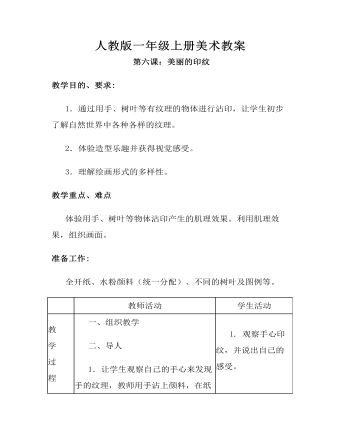
小学美术人教版一年级上册《第6课美丽的印纹》教案
3.让学生讨论并说说除了手之外,还可以用什么东西来印。三、布置作业1.团结协作;2.注意卫生;3.比一比,哪一组印得最美丽。
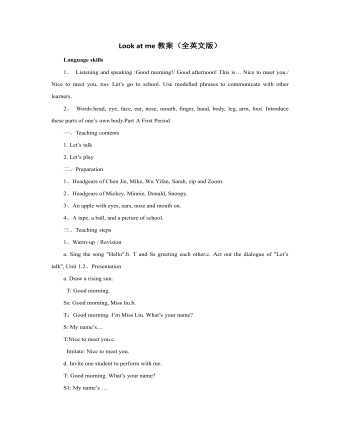
人教版新课标PEP小学英语三年级上册Look at me教案(全英文版)
3、Practicea. Nice to meet you. Nice to meet you,too.b. Perform the dialogue.c. Arrange the dialogue according to the pictures or sentence cards.d. Let’s play.A: Good afternoon,B. This is C. Hello, C! Nice to meet you.C: Nice to meet you, too.A,B: Goodbye!C: Bye!4、Assessment Workbook page 10Add-activitiesa. Listen to the recording and repeat.b. Make a dialogue according to "Let’s talk".Second Period一、Teaching contents1. Let’s learn Words:body, leg, arm, hand, finger, foot.1. Let’s do二、Preparation1、a puppet2、Cards of body, leg, arm, hand, finger and foot.3、headgear of a captain三、Teaching steps1、Warm-up/ Revisiona. Captain says to review "let’s do" of Part A.b. Perform the students their own dialogues.2、Presentationa. Learn to say "body, leg, arm, hand, finger and foot."b. Listen to the recording and repeat.c. Let’s do. Clap your hands. Snap your fingers. Wave your arms. Cross your legs. Shake your body. Stamp your foot.3、Practicea. Let’s draw a person.b. Let’s do. Point out which picture.c. Let’s do. Who responses faster.4、Assessment Workbook page 115、Add-activitiesa. Listen to the recording, repeat and act out.b. Say all the names of the body to your parents.Third Period一、Teaching contents1. Let’s check2. Let’s chant二、Preparation1、stationeries1、pictures of parts of Zoom
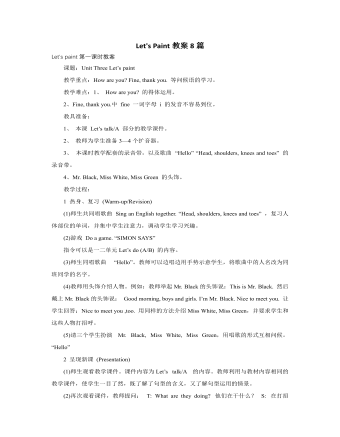
人教版新课标PEP小学英语三年级上册Let's Paint教案8篇
教学设计理念:英语课程标准明确指出,学生的发展是英语课程的出发点和归宿。小学英语课的主要目标是培养学生用英语做事情的能力,同时重视学科内容的有效融合。新课程提倡任务型教学,让学生在教师的指导下通过感知、体验、实践、参与和合作等方式完成教学目标。本着这一理念,我在设计本课时从激发和保持学生的学习兴趣入手,精心创设生活化语言情景,开展丰富多彩的活动,让学生在我的指导下进行语言交流,感受用英语交流的乐趣和成功感,从而培养学生用英语进行交流的能力。教学目标:1. 情感目标:关注学生的内在需要,在活动中培养学生的协作精神和竞争意识,培养学生学习英语的积极情感态度。2. 知识目标:能运用所学语言进行交流。3. 能力目标:通过本课的学习,学生能在实际生活中用英语进行问候;培养学生在课堂上进行自主评价的能力;培养学生根据情景猜测语义和在尝试中自我修正的学习策略。

